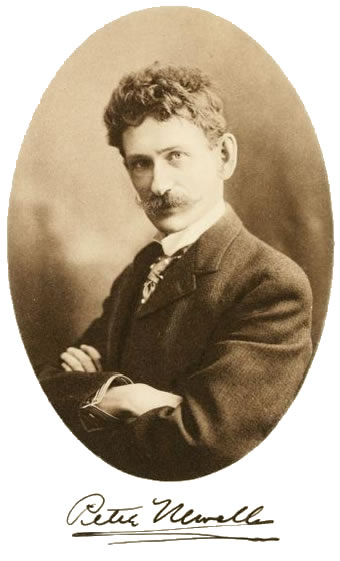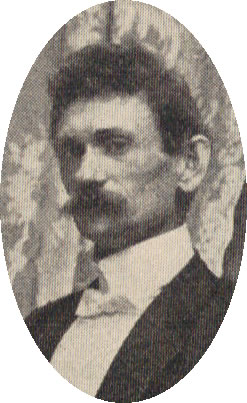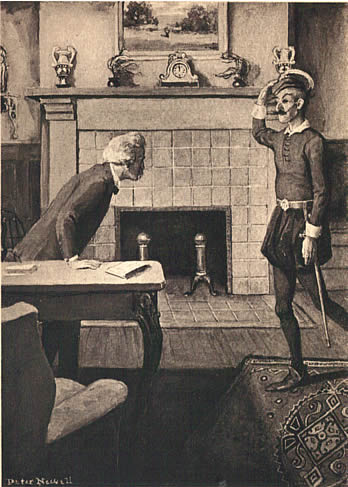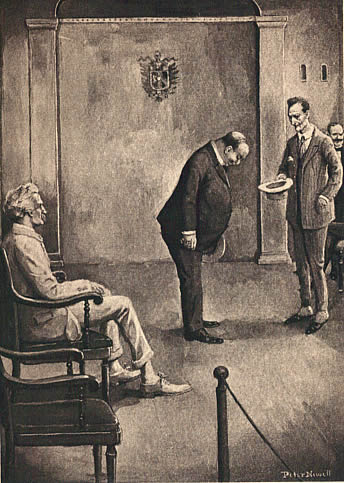Introduction
Volume 29 of the Gabriel Wells Definitive Edition of Mark Twain's works is Europe and Elsewhere, a collection of 35 essays, sketches and travel letters from both previously published and unpublished material. The collection was assembled (and in some cases edited) by Mark Twain's literary executor Albert Bigelow Paine. Printing codes for the book indicate Harper and Brothers printed it in May 1923 and copyrighted the volume in August 1923. It was first issued in Harper's Uniform Library Edition with red cloth and gold cornstalk bindings. The first edition features a full page frontispiece illustration by Peter Newell and "An Appreciation" by Brander Matthews which was actually a reprint of the "Biographical Criticism" that had appeared in Volume 1 of the 1899 uniform edition of Mark Twain's Works issued by American Publishing Company. The first edition of Europe and Elsewhere also contains an introduction by Albert Bigelow Paine. The arrangement of the first edition is the same type of arrangement used for other volumes in the Gabriel Wells Definitive Edition and suggests that the first edition of Europe and Elsewhere was prepared concurrently with the Gabriel Wells Definitive Edition.
An introduction by Albert Bigelow Paine follows the appreciation
by Brander Matthews
|
INTRODUCTION A NUMBER of articles in this volume, even the more important, have not heretofore appeared in print. Mark Twain was nearly always writing -- busily trying to keep up with his imagination and enthusiasm: A good many of his literary undertakings remained unfinished or were held for further consideration, in time to be quite forgotten. Few of these papers were unimportant, and a fresh interest attaches to them to-day in the fact that they present some new detail of the author's devious wanderings, some new point of observation, some hitherto unexpressed angle of his indefatigable thought. The present collection opens with a chapter from a book that was never written, a book about England, for which the author made some preparation, during his first visit to that country, in 1872. He filled several notebooks with brief comments, among which appears this single complete episode, the description of a visit to Westminster Abbey by night. As an example of what the book might have been we may be sorry that it went no farther. It was not, however, quite in line with his proposed undertaking, which had been to write a more or less satirical book on English manners and customs. Arriving there, he found that he liked the people and their country too well for that, besides he was so busy entertaining, and being entertained, that he had little time for critical observation. In a letter home he wrote:
England at this time gave Mark Twain an even fuller appreciation than he had thus far received in his own country. To hunt out and hold up to ridicule the foibles of hosts so hospitable would have been quite foreign to his nature. The notes he made had little satire in them, being mainly memoranda of the moment. . . . "Down the Rhône," written some twenty years later, is a chapter from another book that failed of completion. Mark Twain, in Europe partly for his health, partly for financial reasons, had agreed to write six letters for the New York Sun, two of which -- those from Aix and Marienbad -- appear in this volume. Six letters would not make a book of sufficient size and he thought he might supplement them by making a drifting trip down the Rhône, the "river of angels," as Stevenson called it, and turning it into literature. The trip itself proved to be one of the most delightful excursions of his life, and his account of it, so far as completed, has interest and charm. But he was alone, with only his boatman (the "Admiral") and his courier, Joseph Very, for company, a monotony of human material that was not inspiring. He made some attempt to introduce fictitious characters, but presently gave up the idea. As a whole the excursion was too drowsy and comfortable to stir him to continuous effort; neither the notes nor the article, attempted somewhat later, ever came to conclusion. Three articles in this volume, beginning with "To The Person Sitting in Darkness," were published in the North American Review during 1901-02, at a period when Mark Twain had pretty well made up his mind on most subjects, and especially concerning the interference of one nation with another on matters of religion and government. He had recently returned from a ten years' sojourn in Europe and his opinion was eagerly sought on all public questions, especially upon those of international aspect. He was no longer regarded merely as a humorist, but as a sort of Solon presiding over a court of final conclusions. A writer in the Evening Mail said of this later period:
His old friend, W. D. Howells, expressed an amused fear that Mark Twain's countrymen, who in former years had expected him to be merely a humorist, should now, in the light of his wider acceptance abroad, demand that he be mainly serious. He was serious enough, and fiercely humorous as well in his article "To the Person Sitting in Darkness" and in those which followed it. It seemed to him that the human race, always a doubtful quantity, was behaving even worse than usual. On New Year's Eve, 1900-01, he wrote: A GREETING FROM THE NINETEENTH TO THE TWENTIETH CENTURY
Certain missionary activities in China, in particular, invited his attention, and in the first of the Review articles he unburdened himself. A masterpiece of pitiless exposition and sarcasm, its publication stirred up a cyclone. Periodicals more or less orthodox heaped upon him denunciation and vituperation. "To My Missionary Critics," published in the Review for April, was his answer. He did not fight alone, but was upheld by a vast following of liberal-minded readers, both in and out of the Church. Edward S. Martin wrote him:
The
principals of the primal human drama, our biblical parents of Eden,
play a considerable part in Mark Twain's imaginative writings. He wrote
"Diaries" of both Adam and Eve, that of the latter being among
his choicest works. He was generally planning something that would include
one or both of the traditional ancestors, and results of this tendency
express themselves in the present volume. Satan, likewise, the picturesque
angel of rebellion and defeat, the Satan of Paradise Lost, made
a strong appeal and in no less than three of the articles which follow
the prince of error variously appears. For the most part these inventions
offer an aspect of humor; but again the figure of the outcast angel
is presented to us in an attitude of sorrowful kinship with the great
human tragedy.
ALBERT BIGELOW PAINE. |
Illustration List for Volume 29
|
The first edition of Europe and Elsewhere features a frontispiece illustration by Peter S. Newell (b. 1862 - d. 1924) for the essay "Sold to Satan." The Gabriel Wells Definitive Edition features this same frontispiece plus three additional full-page illustrations. Two are signed by Newell and the third is likely his work as well. No previous publications of Newell's illustrations in Europe and Elsewhere have been found. Newell had illustrated a number of Mark Twain's texts prior to Europe and Elsewhere. In 1897 he contributed illustrations to the first edition of Following the Equator from American Publishing Company. In 1899 he provided illustrations for the American Publishing Company's uniform edition of The Innocents Abroad. When Mark Twain's "The $30,000 Bequest" was originally published as a short story in Harper's Weekly, December 10, 1904 it featured illustrations by Peter Newell. Volume 24 of the Gabriel Wells Edition features one of Newell's original illustrations for "The $30,000 Bequest." |
 |
By 1905 Newell's work was held in such high regard by Harper and Brothers that he was one of the elite who received an invitation to attend Mark Twain's seventieth birthday celebration held on December 5, 1905. According to a news story in The New York Times:
There were 170 of his friends and fellow-craftsmen in literature gathered in the Red Room at Delmonico's for the celebration. Barring a half dozen or so, all were guaranteed to be genuine creators of imaginative writings -- or illustrators of such writings. The guarantee was furnished by Col. George Harvey, editor of The North American Review, who was the host of the evening as well as the Chairman. ("Celebrate Twain's Seventieth Birthday," The New York Times, 6 December 1905.)
| Some of Newell's illustrations for Europe and Elsewhere feature characters who bear a striking resemblance to his own appearance. |  1905 photo of Peter Newell from Mark Twain's seventieth birthday celebration held 5 December 1905. |
 Newell's f rontispiece for Europe and Elsewhere featuring Mark Twain meeting the character Satan who resembles Newell himself. |
 Newell's illustration for "Marienbad -- A Health Factory" also features Mark Twain |
The illustrations for Volume 29 of the Gabriel Wells Definitive Edition of Europe and Elsewhere:
In addition to Newell's illustrations, Europe and Elsewhere also features nine humorous illustrations by Mark Twain to accompany his essay "Instructions in Art" which are embedded within the text of the essay and not listed in the illustrations list.
Full Text Online Availability Via Archive.Org
Volume
29
_____
"Celebrate Twain's Seventieth Birthday," The New York Times, 6 December 1905.
Johnson, Merle. A Bibliography of the Works of Mark Twain. (Harper and Brothers, 1935).
Mark Twain's 70th Birthday: Souvenir of its Celebration. Supplement to Harper's Weekly, 23 December 1905.
Rasmussen, R. Kent. Critical Companion to Mark Twain: A Literary Reference to His Life and Work, Volumes 1 and 2. (Facts on File, 2007).